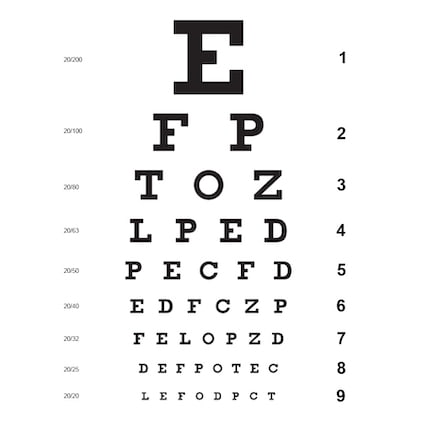Online eye test: Check your eyesight for free now

The World Health Organization estimates that approximately 2.2 billion people live with some form of vision impairment.1 So how do you find out if your eyes need help? And how do you measure your own eyesight? This article will provide you with a good starting point.
A brief history of eye charts
The inventor typically credited with creating the first eye chart is German ophthalmologist Heinrich Küchler around 1835. Dutch eye doctor Herman Snellen later developed a chart in 1862 that standardized Küchler's design of progressively smaller text. The early Snellen charts used symbols, but eventually evolved to incorporate specifically shaped letters. Snellen charts with slight variations would go on to became the norm and are still used today to measure eyesight.2 During an eye exam with a Snellen chart, your eye doctor will ask you to read the smallest line of letters you can. Put plainly, if you're able to read the bottom row of letters, your visual acuity is excellent.
Take an eye test here
If you want to find out whether you need glasses or contact lenses, you should book an eye test with your local eye care practitioner. Before visiting a professional, you can try our online eye chart, which may give you an initial indication whether or not you have issues with distance vision.
Please note: This chart is not a substitute for an actual eye exam performed by a medical professional. This chart is half the size of a regular Snellen chart and is designed to fit on one sheet of A4 paper for easy home printing. Due to ocular accommodation, in which your eyes can adjust to visual weaknesses at 5 metres/16 feet and under, the results from 3 meters/10 feet are not as accurate as those based on a larger chart from the official medical distance of 6 metres/20 feet.
The test we're providing here is only for testing nearsightedness, which means blurry distance vision. Farsightedness, astigmatism and other eye problems can't be measured with our chart. Only a comprehensive eye examination by a licensed optometrist can determine whether your eyes are healthy and you can see as clearly and comfortably as possible.
How to use our online Snellen eye chart
- Print the chart on a piece of A4 paper with print scale set to 100%.
- Place the chart on a wall and stand 3 metres/10 feet away.
- Cover one eye and read the letters on the chart from top to bottom.
- Repeat with the other eye, and then with both eyes together.
- The smallest row of letters that you read accurately determines visual acuity in the uncovered eye.
How to interpret your results
The results of your chart reading will determine the quality of your eyesight. Your results will be expressed as a fraction based on traditional-sized chart measurements. Fractions are shown to the left of each row and identify how well you can see. For example:
- 20/20 vision: If you can read clearly to the ninth line, your vision is 20/20. This means you can read the same line of letters at 20 feet / 6.09 metres that people with normal vision can read at 20 feet / 6.09 metres.Your vision is considered ideal by medical standards.
- 20/40 vision: If you can read clearly to the sixth line, your vision is 20/40. This means you can read the same line of letters at 20 feet / 6.09 metres that people with normal vision can read at 40 feet / 12.2 metres. The 20/40 line is the standard cutoff point for needing corrective lenses. If this line cannot be read, then vision correction is typically prescribed.
Catching vision issues early on and raising awareness can help create a clearer world for everyone. Here’s to healthy eyes!
Sources
1. The World Health Organization, Blindness and visual impairment
2. The National Library of Medicine, Evaluation of Visual Acuity
Comments
Add a questionWill the eye get normal vision after wearing glasses? Will refractive error progress in a week? Is it necessary to use glasses all the time?
Thank you for your comment.
While it is possible that the dioptres do increase over time (and age), changes usually do not occur over a week.
The glasses will correct the vision whilst wearing them.
We'd suggest contacting your ophthalmologist to discuss how you should be wearing your glasses.
Regards.
Thank you for your comment.
In order for the body and brain to get used to the new prescription glasses, it is recommended to wear them for at least 3 days to evaluate their use.
If you experience any discomfort, please contact your eye specialist.
Have a lovely day.
They are comfortable, but I have found that I need to push back reading material farther away from my eyes. Also everything appears much smaller, and incredibly clear than without glasses.
The prescription is, right eye - 1.75, and left eye -1.50.
The doctor said that I will probably need stronger lenses within a year, after my eyes get used to these. He said that this is a fairly strong first prescription.
My distance vision began to get quite blurred after I began working on a desktop for several hours a day.
Thank you for your comment.
It depends on your personal feeling, as long as you do not feel any discomfort when looking, it is not necessary to wear glasses.
If you would like to be sure that everything is fine, we recommend that you visit an eye specialist who will provide you with professional care.
Have a lovely day.
we regret if there is some issue. The test is for informational purposes only, you will need to see an eye specialist to have your vision measured correctly.
Have a lovely day.
Thank you for your comment and for sharing your story.
We recommend following your doctor's recommendations and we wish you the best of luck with the appeal.
Kind Regards.
Hello Sue,
Thank you for your comment.
I am sorry to hear that you did not have a good experience with your
ophthalmologist.
We would suggest a consultation with another specialist, so you can be sure
that a proper diagnosis is done.
Regards.









Mohd H.
Can i recover my eyesight?
Engaging in eye exercises can be highly beneficial for maintaining eye health and may contribute to stopping the progression of diopters or even improving your vision.
Nevertheless, I would strongly advise consulting with a doctor who can provide you with a more accurate prognosis.
Best regards,